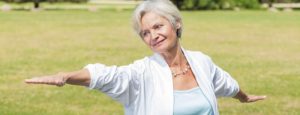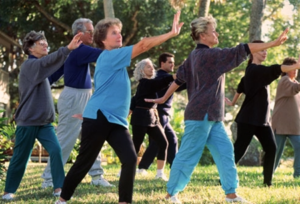Improve Osteopenia and Osteoporosis with Tai Chi
By John M. de Castro, Ph.D.
“There are many ways that tai chi helps people with osteoporosis. An excellent study showed tai chi slowed down the loss of bone density approximately three fold.” – Paul Lam
Bone is living tissue that, like all living tissues, is constantly being broken down and replaced. Osteopenia and Osteoporosis occur when the creation of new bone doesn’t keep up with the removal of old bone. This results in a loss of bone mass, causing bones to become weak and brittle. It can become so brittle that a fall or even mild stresses like bending over or coughing can cause a fracture. These fractures most commonly occur in the hip, wrist or spine. Osteoporosis is estimated to affect 200 million women worldwide. In the United States 54 million adults over 50 are affected by osteoporosis and low bone mass. Osteoporosis takes a huge personal and economic toll. The disability due to osteoporosis is greater than that caused by cancers and is comparable or greater than that lost to a variety of chronic diseases, such as arthritis, asthma and high blood pressure related heart disease.
The most common treatments for osteoporosis are drugs which slow down the breakdown of bone, combined with exercise. The side effects of the drugs are mild, including upset stomach and heartburn. But there is a major compliance problem as the drugs must be taken over very long periods of time. In fact, only about a third of patients continue to take their medications for at least a year. Even when drugs are taken, exercise is recommended to improve bone growth. Indeed the mindful movement exercise of yoga has been shown to improve osteoporosis. The ancient mindful movement technique Tai Chi is a very safe form of gentle exercise that is beneficial for the prevention and treatment of osteoporosis. With accumulating evidence it is a good idea to step back and summarize what is known about the application of Tai Chi practice for the treatment of osteoporosis.
In today’s Research News article “Tai chi for treating osteopenia and primary osteoporosis: a meta-analysis and trial sequential analysis. Clinical interventions in aging.” (See summary below or view the full text of the study at: https://www.ncbi.nlm.nih.gov/pmc/articles/PMC6322510/ ), Zhang and colleagues review, summarize and perform a meta-analysis of the published research literature regarding the application of Tai Chi practice for the treatment of osteopenia and osteoporosis. They discovered 15 published randomized controlled trials.
They found that the research studies reported that Tai Chi practice produced a significant increase in bone mineral density and bone gla protein. In addition, Tai Chi practice produced a significant reduction in pain from osteoporosis. These are positive and encouraging results but the authors caution that the quality of the studies was not high and that larger better controlled trials are needed.
Tai Chi is gentle and safe mindfulness practice. It is appropriate for all ages including the elderly and for individuals with illnesses that limit their activities or range of motion. It is inexpensive to administer, can be performed in groups or alone, at home or in a facility, and can be quickly learned. In addition, it can be practiced in social groups. This can make it fun, improving the likelihood of long-term engagement in the practice. So, Tai Chi practice would appear to be an excellent gentle mindfulness training and light exercise to improve bone density in patients with osteopenia and osteoporosis.
So, improve osteopenia and osteoporosis with Tai Chi.
“Tai chi has lots of potential benefits that are well-proven. Even if its direct effects on bone strength and quality are limited, it can still help prevent fractures because it improves balance, neuromuscular coordination and postural stability, thus reducing the risk of falls.” – Berkeley Wellness
CMCS – Center for Mindfulness and Contemplative Studies
This and other Contemplative Studies posts are e also available on Google+ https://plus.google.com/106784388191201299496/posts and on Twitter @MindfulResearch
Study Summary
Zhang, Y., Chai, Y., Pan, X., Shen, H., Wei, X., & Xie, Y. (2019). Tai chi for treating osteopenia and primary osteoporosis: a meta-analysis and trial sequential analysis. Clinical interventions in aging, 14, 91-104. doi:10.2147/CIA.S187588
Abstract
Purpose
The aim of this meta-analysis was to evaluate the efficacy of Tai chi (TC) as an adjuvant treatment for osteopenia and primary osteoporosis.
Methods
We went through eight databases to identify relevant randomized controlled trials that compared TC with a control group. The primary outcome was osteoporosis-related fractures (fracture incidence). Meta-analyses and trial sequential analyses (TSA) were conducted using RevMan 5.3 and TSA 0.9.
Results
Fifteen randomized controlled trials involving a total of 857 patients were included in the analyses. No trials reported primary outcome; however, bone mineral density (BMD) values differed significantly in subgroup 1 (TC vs no treatment; weighted mean difference [WMD] =0.05 g/cm2, 95% CI 0.03 to 0.07; P<0.00001; P for heterogeneity =0.22, I2=22%) and subgroup 2 (TC vs conventional treatments; WMD =0.16 g/cm2, 95% CI 0.11 to 0.21; P<0.00001; P for heterogeneity =0.008, I2=75%). In addition, two trials compared TC with conventional treatments, which found a significant difference in bone gla protein (standardized mean difference =−1.18, 95% CI −1.66 to −0.70; P<0.00001; P for heterogeneity =0.58, I2=75%). The results of the BMD were confirmed by TSA. Also, TC may have a certain effect on the relief of osteoporotic pain (WMD = −2.61, 95% CI −3.51 to −1.71; WMD = −1.39, 95% CI −2.01 to −0.77). However, it did not promote the quality of life, level of serum calcium, serum phosphorus, and also had no effect on bone turnover markers.
Conclusion
Although there is no study monitoring fracture incidence, TC may be beneficial for patients in improving BMD values, level of bone gla protein, and relieving osteoporotic pain. However, due to the low methodological quality, current evidence for treating osteopenia and primary osteoporosis through TC is insufficient.
https://www.ncbi.nlm.nih.gov/pmc/articles/PMC6322510/



